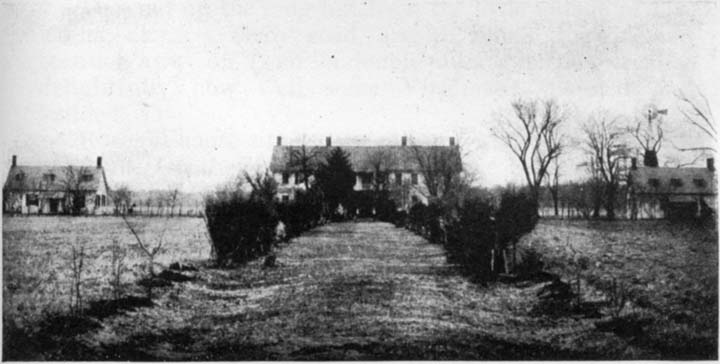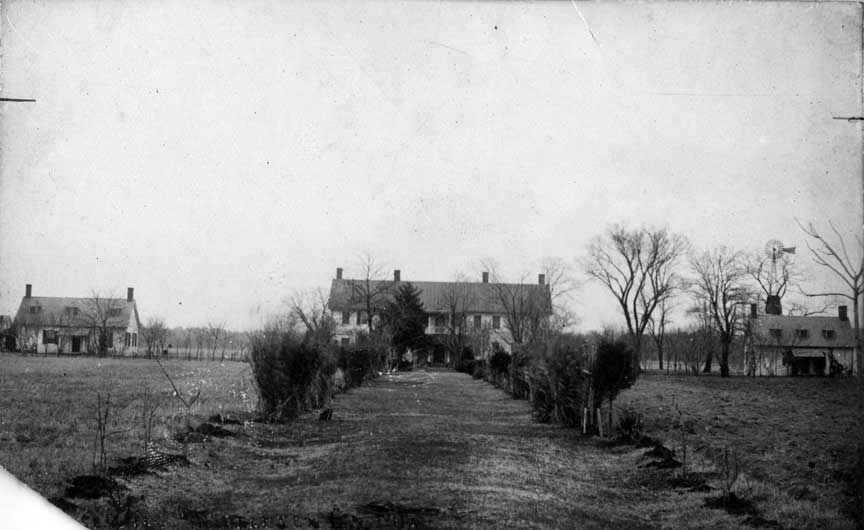| Historic Virginia Homes and Churches |
|
From "Historic Virginia Homes and Churches" |
ROSEGILL
Picturesque in the extreme is this old estate—and not only in its outward and visible form but as well in the inward and spiritual things. For generations the home of “Wormeley of Virginia”—scions of the house of “Hatfield,” Yorkshire, England—ancient and honorable—Rosegill is perhaps the least popularly known of Virginia’s colonial estates. In the third decade of the seventeenth century Christopher and Ralph Wormeley “came out” to Virginia and founded their first home in York County, each becoming a member of that “Virginia House of Lords”—the governor’s Council of State. In 1649, Ralph Wormeley patented a tract of land wonderfully situated on the Rappahannock River—in what is now Middlesex County, at that date Lancaster—removing thither, establishing “Rosegill,” “passing” in the year of our Lord 1651 from this truly “earthly paradise”—we trust, to that one “not made with hands.” Agatha (of the name and family of “Eltonhead of Eltonhead”), widow of the first Ralph Wormeley (who was her second husband), took unto herself a third mate—the distinguished Sir Henry Chicheley, Knight, a cavalier officer, member of the Governor’s Council in Virginia and deputy governor of the Colony—who made Rosegill his home throughout the remainder of his days.
Ralph Wormeley (1650-1700), second of the name, son of Ralph and Agatha (Eltonhead) Wormeley, matriculated at Oriel College, Oxford, in 1665, and, completing his education, returned to Virginia, where the succeeding years of his life proved a veritable multiplication table of honors: burgess, member of the Council, secretary of State, trustee of William and Mary College, naval officer of the Rappahannock, president of the Council; “the most powerful man in Virginia,” according to a contemporaneous report. From him descended a line—all Ralphs, with one exception, all masters of Rosegill and in economic, social and political “estate” among the foremost men in Virginia.
The beginning of the Revolutionary struggle found two of the family resident at Rosegill—Ralph Wormeley (1715-1790), fourth of the name, for twenty-two years a member of the House of Burgesses, and his son Ralph Wormeley (1744-1806), the fifth, educated at Eton and Cambridge, one of the greatest book-collectors in Virginia and one of the last appointees to the Council under the Royal government. These honorable gentlemen both sympathized with the mother country in the revolt of her children, but, wise in their generation, they did not offer active opposition to the “new order” forming around them. Their passive attitude did not, however, save them from great annoyance during the war.
Ralph, the younger, in a letter to John Randolph Grymes, dated 4 April, 1776, expressed himself quite freely in “loyal terms”; the letter was intercepted, and Wormeley was ordered by resolution of the Virginia Convention to be confined to the county of Berkeley and that part of his father’s estate which was in the county of Frederick, and not to depart the limits thereof, and to give bond for £20,000. For two years his movements were thus restricted. After his release he returned to Rosegill, where, in 1781, oh, irony of fate! his estate was pillaged and he robbed, by the crew of a tory privateer, of thirty-six valuable slaves, silver plate, jewelry, watches and wearing apparel, some of the property, however, being later returned on application to General Leslie, the English officer then commanding at Portsmouth.
The two Wormeleys, however, survived the war and lived to enjoy the friendship of the citizens of the new State, the younger Ralph serving several times as a member of the House of Delegates and in the Virginia Convention of 1788. Not long after his death, in 1806, Rosegill was sold and in the course of years, passing through various ownerships, was some time since purchased by the late Senator Cochran of Pennsylvania, who restored the old mansion with the utmost care and good taste.1
The distant view of Rosegill given in the illustration (the only available one) hardly does justice.

|
This photograph is taken from the river side of the houses. Note the allee of trees and shrubs. The kitchen on the right does not have the small kitchen that was there in the 1944 appraisal. Note the windmill. As this book was published in 1915, it appears to date from 1915 or earlier. |

|
This photograph is at the Valentine Richmond History Center in the collection of photographs by Robert A. Lancaster. Lancaster began collecting photographs of old Virginia houses in 1888 and published the book in 1915. No date information is recorded on the photograph. Note that this photograph shows a little more detail on the sides of the picture. To the east of the manager's house, there is an additional gable roof, but it is not the same height as the roof of the house itself, while the summer kitchen with its roof on the same height must have been added later. To the right side of the photograph is possibly the roof of the barn. This image is the property of the Valentine Richmond History Center and intended for personal research only. The image may not be reproduced or exhibited without the express written permission of the Valentine Richmond History Center. |
Encircled with wild roses and honeysuckle, this wonderful old Virginia homestead deserves its pretty romantic name.
To wind up the long hill from the little village of Urbanna, along a shady road, and to behold the fine old mansion away off from its double outer gates is to realize delightfully how well some Virginians planned and builded.
Rosegill house sits square and imposing in thirty acres of lawn. On the left, as one enters the land gate, is the great kitchen, still glorying in its fireplace, crane, spiders and pot hooks.
The “mansion house” is unique. From the land porch a square hall opens; to the left of this are a sitting-room and a dining-room, both immense, to the right are the library and drawing-rooms, equally spacious. The dining-room is panelled in mahogany, the sitting-room as well as the library in oak, while the drawing-room is in white. Parallel to these large apartments runs one splendid hall, with a large door, and eight large windows with seat, opening to the square river porch. At either end of this very large hall are winding stairs.
Above are five great chambers and another sweep of hall with windows overlooking the Rappahannock.
In the attic is one great chamber with fourteen beds for bachelors. The lawn from the back hall runs to the Rappahannock, which is at this point five miles wide. The green walk from the house to the river is bordered with roses its whole length.
|
1. For Wormeley Genealogy, see Hayden, Virginia Genealogies, and Virginia Magazine of History and Biography, viii, p. 179 et seq.; xvi, p. 16 et seq., and xviii, p. 373 et seq. |
|
|